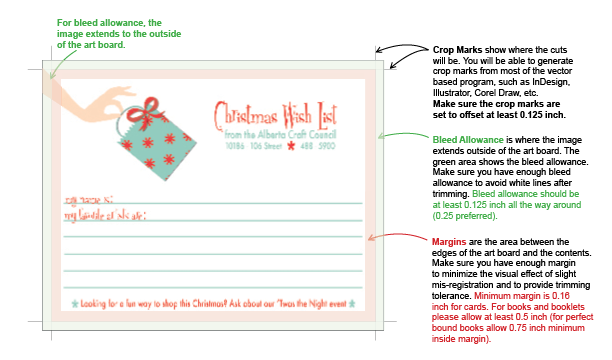Printing Terms and Tips
Bleeds, crops, margins, color space, resolution, file formats and other printing terms explained to help you get the best possible printing at PageMaster.

Crop Marks
Often, multiple copies of a document can be printed onto a single sheet of paper, then cut. When this is done, marks need to be created to tell us where to “crop” the document crop marks show where the cuts will be.
You will be able to generate crop marks from most of the vector based programs, such as InDesign, Illustrator, Corel Draw, etc. Make sure the crop marks are set to offset at least 0.125 inch.
Bleeds
If your document contains color or images right up to the edge, it requires a bleed allowance. Bleed allowance is where the image extends outside of the art board (the document’s actual edges). The printing process can create small variations on exactly where cuts are made during the trimming process, and if a cut is made just outside of the art board, the edge of your final document will have a white line (the color of the paper), rather than the full-bleed image you intended. To avoid this, you let your image spill or “bleed” over the edges, by at least 0.125 inches, all the way around. This is the bleed allowance. You don’t want anything in this extended area to be important to your document, because it will likely never be seen. Its only added to make room for very small variations in folding and trimming.
Margins
Margins are the areas between the edges of the art board and the contents of your document. Make sure you have enough margin to minimize the visual effect of slight mis-registration (variation in printing) and to provide trimming tolerance. Specs for book interiors are here: https://pagemaster.ca/interior-margins-for-standard-book-size/
Minimum margin is 0.2 inch for cards. Please allow at least 0.5 inch for books and booklets.
File Formats and Photo Resolution
Ensuring your file is delivered in the best format possible will make for smooth sailing on your next print job.
PDF is the preferred file format for documents ready to print.
Preferred File Formats:
Ready to print:
– PDF (preferred for all vector based graphics or anything contain text)
- embedded fonts
- high resolution images, minimum at 150 dpi at print size, optimum at 300 dpi, down-sampling maybe be needed for anything higher than 300 dpi
- embedded color profile
- bleed allowance if there isn’t a white border on the work
- crop marks if there are bleeds or the work is not letter or tabloid size
– TIFF (preferred for photographs/CG images), also for images to be included in design and production projects
- For laser output, minimum at 200 ppi at print size, optimum at 300 dpi at print size
- For wide-format giclee output, minimum at 144 ppi (some artifacts will show at close viewing distance), optimum at 300 dpi at print size
Other acceptable file formats:
- JPG/JPEG
- doc/docx, rtf (Proofing required before printing, PDF setup charge may apply)
- CDR, Ai, PSD, (Fonts, Images must be embedded) May require proofing.)
For all other file formats, please contact us before submission.
File Resolution and Artifacting
Have you ever printed something that looked great on screen, only to have it appear blurred or blocky when printed? The reason was most likely a low resolution image or lossy degradation. The higher the resolution of the image, the greater detail and size can be achieved when printing that image. You’ve likely encountered resolution before, when dealing with digital cameras (for instance, a newer digital camera may be able to produce photos whose resolution is 14 Megapixels).
For images you want us to print or use in creating for you, optimum quality is at a resolution is set to 300 PPI (pixels per inch) at actual size, or a minimum of 240 PPI whenever possible.
JPG is lossy and each time you make a change and save the file there is some loss. Over-sharpening can also severely affect the quality of a piece. Saving once as a JPG maximum can save transmission time but a compressed Tiff could yield superior results. Web images are optimized for speed and generally are not acceptable in print.
For line art, a resolution 600 DPI (dots per inch) is requested.
Color Profiles and Spaces
Ensure color profiles are included in all color critical work. They help translate color to the best each device can produce. It is best to embed profiles rather than converting and allow the device to translate color.
For images, RGB color space is preferred as the devices will give their best color. Our wide format printer runs both RGB and CMYK color spaces giving a very large gamut. CMYK color space is more repeatable but a smaller gamut.
Have Questions?
We can help you wade through the technical jargon. If you have any question about the files you are sending to us, files you are building, or any technical printing questions at all, please contact us.
